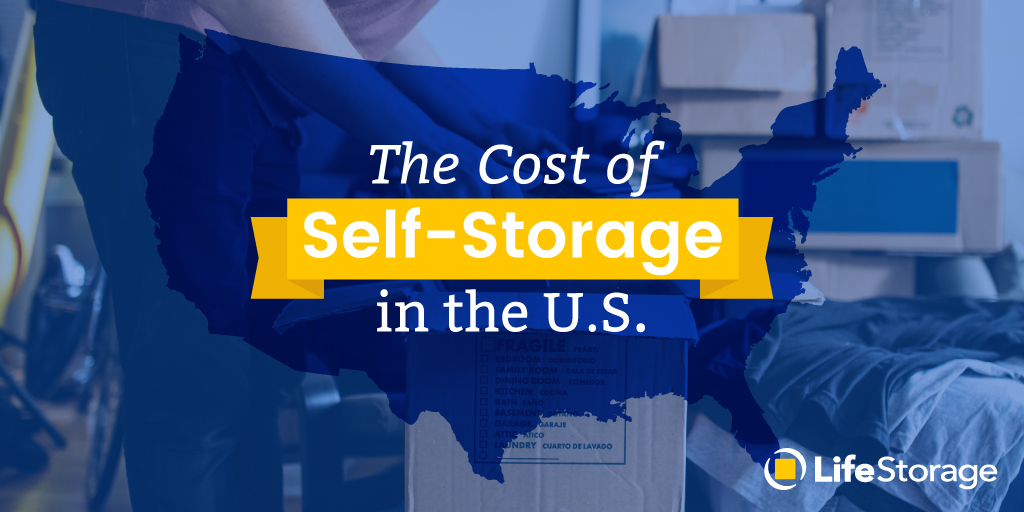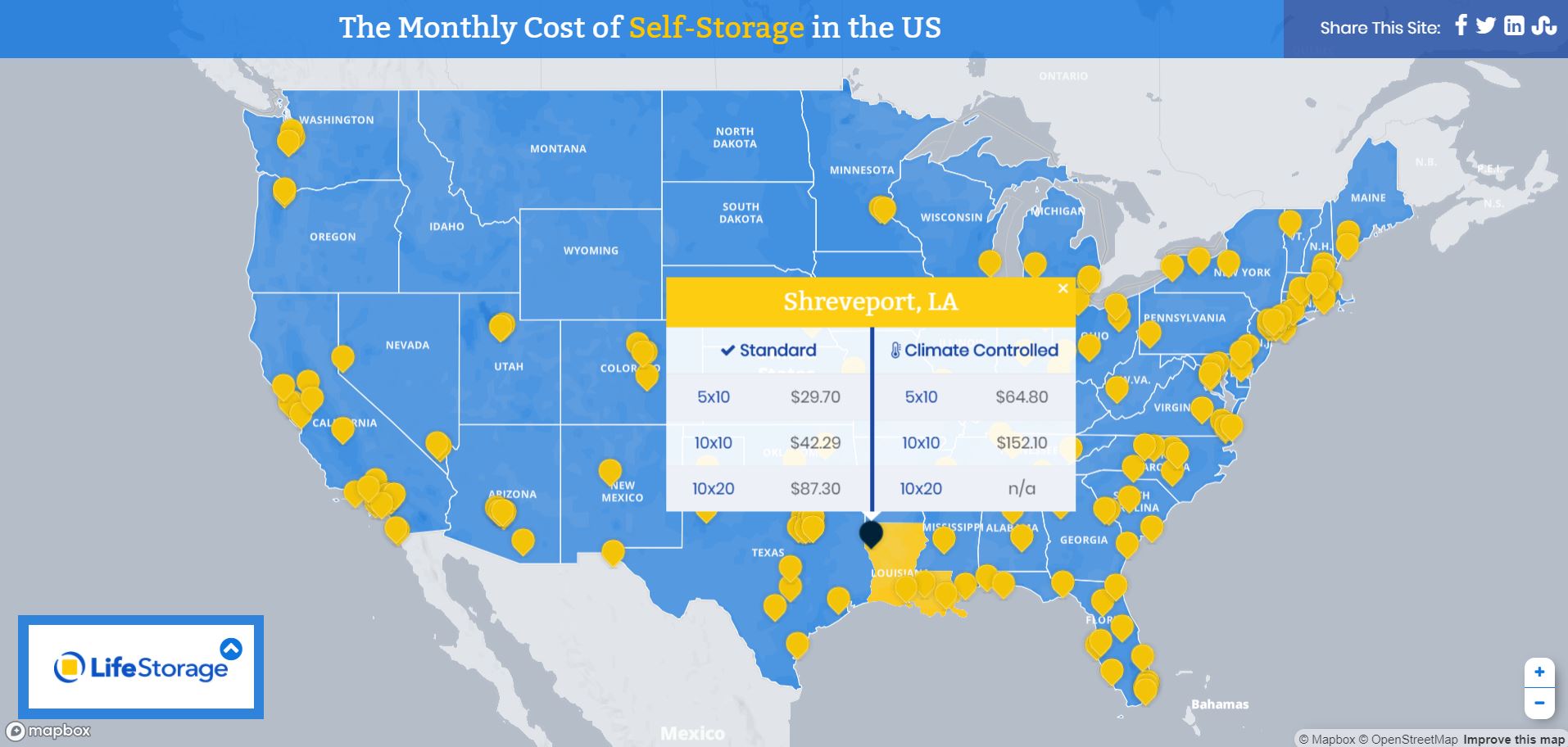Imagine that you’re embarking on a worldwide solo-travel adventure and need a place to stash your things while you’re away. Or perhaps you’re temporarily moving back home and need somewhere to store your belongings while you’re temporarily rooming with Mom and Dad again.
Whatever the case, it’s incredibly common to need some extra storage space from time to time. (Especially if you live in a small apartment or condo in a big city!) But if you’re brand new to the self-storage world, it’s hard to know where to start. How much should you expect to pay monthly for a storage unit, and how does paying for storage work, anyway?
We’ve compiled this comprehensive storage unit cost & pricing guide to answer all your burning questions and more. You’ll also be able to use our interactive pricing map to get a high-level overview of storage unit prices as you compare unit sizes and amenities by region.
Related: 12 Seasonal Storage Solutions Everyone Should Know
How much does it cost to rent a storage unit?
Simply put: It depends. The cost of a storage unit tends to vary based on a number of unique factors like size, amenities, temperature (climate-controlled or not), and unit availability. Plus, storage unit costs vary from state to state and city to city. So if you’re looking for a larger, climate-controlled self-storage unit in a major metro area, for example, you can expect to pay a higher monthly fee than someone renting the smallest standard unit in a less populated city.
Compare Storage Unit Prices

Below are the nationwide price averages for our most popular storage units. Our analysis looks at the three most popular unit sizes: 5’ x 10’, 10’ x 10’, and 10 ’x 20’.
Note: To determine the average monthly cost for self-storage in various cities nationwide, we combined our pricing data with three of the other largest self-storage companies in the United States. So whether it’s standard or climate-controlled storage you’re looking for, we’ve got pricing for several cities.
Pro Tip: For expert advice on selecting a storage unit size, try our size estimator or call your local Life Storage. Our store managers would be happy to help!
Related: How to Store Furniture in a Garage or Storage Unit the Right Way
What is the average price of a storage unit in the USA?
To give you a general idea of what you’ll be paying monthly for a self-storage unit, let’s break it down by size:
Average Monthly Cost for a 5’ x 10’ Storage Unit
Standard unit: $66.11
Climate Controlled: $74.21
A 5×10 unit is right for you if: You’re looking for a space to store your lawnmower and other similarly-sized yard equipment, a sofa, a chest of drawers that don’t have a place or your home right now, or a dozen boxes.
Average Monthly Cost for a 10’ x 10’ Storage Unit
Standard unit: $116.46
Climate Controlled: $134.20
A 10×10 unit is right for you if: You’re looking to store average-sized pieces of furniture or the contents of a one-bedroom apartment, including a few large home appliances.
Average Monthly Cost for a 10’ x 20’ Storage Unit
Standard unit: $259.10
Climate Controlled: $269.49
A 10×20 unit is right for you if: You’re looking to store a few rooms worth of furniture and belongings. This size unit is designed to house the furnishings and appliances from a 2-3 bedroom home.
Related: Is Living in a Storage Unit Legal?
Average Storage Unit Cost by City
Are you curious about the monthly storage unit rates in your current (or soon-to-be) city? To help you visualize the difference in cost based on your location, we created an interactive tool that maps out average monthly storage prices for the most popular unit sizes in cities across the U.S.
Simply locate and click on your city on the map below. There you’ll find the average monthly costs for climate-controlled and standard 5’ x 10’, 10’ x 10’, and 10 ’x 20’ size units.
Click the Image Below to View this Storage Cost Map

Where in the US are storage units the most expensive?
Orange County, CA, averaged the highest monthly prices for storage units – it was the highest for 2 of the six-unit types and second highest for 3 of the remaining unit types. Small living spaces in popular neighborhoods like Manhattan, Queens, and Brooklyn drive a continual demand for storage. This means higher prices in comparison to other U.S. cities.
Regardless of what size storage unit is right for you, though, the monthly price will generally always be higher in larger cities like New York City, Chicago, and San Francisco. In Long Island, for example, you’ll pay around $380 per month for a standard 10’ x 20’ unit and about $440 for the same size with climate control.
Where in the US are storage units the least expensive?
On the contrary, which states can you expect to pay the least for a self-storage unit in the U.S.? Warren, OH, currently touts the lowest monthly prices for all sizes of standard units. But climate-controlled units are another story. Philadelphia, PA, has the lowest monthly rates for a 10’ x 10’ climate-controlled storage unit, while Montgomery, AL, had the lowest monthly price for a 5’ x 10’ and 10’ x 20’ unit.
Related: How Does Self-Storage Work? Here’s What You Need to Know
Monthly Storage Unit Costs by U.S. City
Standard Self-Storage Unit Costs by City
Climate-Controlled Storage Costs by City
Is Renting a Storage Unit in Your City a Good Idea for You?
Now that you know the average monthly rates for popular storage sizes, how can you get the best bang for your buck? In short, do your research before signing on the dotted line to confirm you’re getting the best possible rate. That means looking up local storage unit rates online, calling multiple locations, or even speaking with a self-storage expert to help guide your decision. Once you rent a storage unit, you should also be sure to use your space efficiently so that you don’t pay more than necessary each month.
Are there any cities you’re curious about that we didn’t include in our analysis? Let us know on Facebook!
Read These Storage Guides Next:
- How to Pick the Best Storage Unit Size for Your Needs
- How to Clean Out a Storage Unit
- Self-Storage FAQs – Renting a Storage Unit
This post originally appeared on the Life Storage blog on 3/6/18. On 7/28/20 and 5/12/23, it was revised to provide new information.







